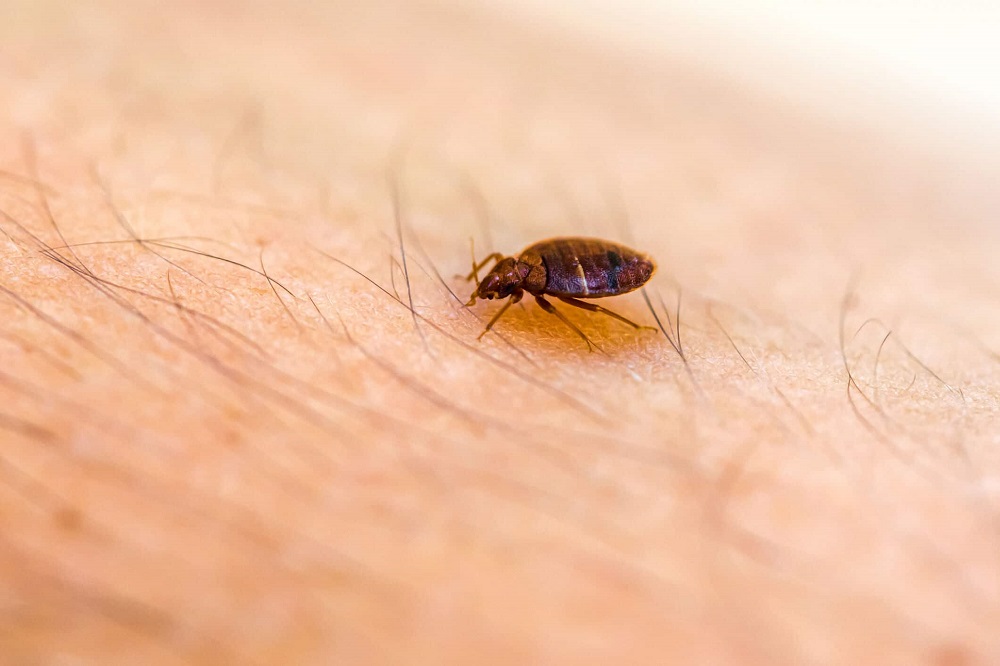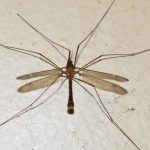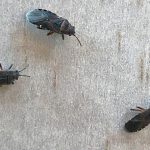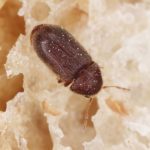Bed bugs are the ultimate unwelcome house guests. These tiny, reddish-brown insects feed on human blood and leave behind itchy, painful bites that can last for days. But here’s the burning question: can bed bugs get on your skin? The answer is a resounding yes.
These crafty critters are experts at hitchhiking and can easily climb onto your clothing, bags, or even your body as you sleep. They’re attracted to the warmth and carbon dioxide we emit, making us prime targets for their blood-sucking ways. Once they’ve landed on your skin, they’ll usually crawl around for a few minutes before settling in to feed.
Bed bugs bite exposed skin like your face, neck, arms, and hands, leaving behind itchy, unbearable welts. In some cases, these bites can even cause an allergic reaction. If you suspect that you have a bed bug infestation in your home, don’t hesitate to take action immediately. These pests reproduce quickly and spread from room to room with ease.
In this blog post, we’ll explore how bed bugs get on our skin and what steps you can take to prevent and treat their bites. So grab a cup of coffee (or tea) and dive in together.
How Do Bed Bugs Get On Your Skin?
Contents
Bed bugs are tiny, reddish-brown insects that are notorious for feeding on human blood. These nocturnal creatures hide in crevices and cracks during the day and come out at night to feed on their unsuspecting hosts. But how do bed bugs get onto your skin? Well, let me enlighten you – they’re expert climbers.
Unlike other pests with wings or jump, bed bugs have cunning claws that enable them to scale walls and furniture quickly. If they need to reach their host and have no other way of doing so, bed bugs will climb onto their skin and begin feeding. They are attracted to the warmth of your body and the carbon dioxide you exhale as you breathe.
While sleeping, bed bugs will crawl onto your skin, seeking exposed areas such as the neck, face, arms, or hands. The bites are painless as the bed bug injects some anesthetic into your skin. This numbs the area around the bite site, so you won’t even feel them biting you.
They also inject an anticoagulant that prevents blood from clotting so they can feed uninterrupted for several minutes.
It’s important to note that bed bugs like lice or fleas do not live on your skin. They crawl onto your skin to feed and then crawl back off again. Therefore, washing your skin or showering will not eliminate bed bugs.
If you suspect that you have an infestation of these pesky creatures in your home, it’s crucial to take action right away.
Bed bugs reproduce rapidly, so even a minor infestation can quickly escalate into a significant problem. Although bed bug bites are not known to transmit diseases, they can cause immense discomfort and itching.
Individuals allergic to the bites may experience severe reactions such as swelling and difficulty breathing.
Signs of Bed Bug Bites
Bed bugs are notorious for their stealthy behavior and ability to make us itch and scratch all night. But how can you spot the signs of bed bug bites? This article will explore the telltale signs of bed bug bites and how to protect yourself from these pesky critters.
One of the most common signs of bed bug bites is the appearance of red, itchy welts on your skin. These welts may be arranged in a zigzag pattern or a line and can be accompanied by swelling.
Another sign to look out for is small, raised bumps on your skin that may also be accompanied by itching and redness. In rare cases, bed bug bites may appear as tiny blisters or hives.
It’s important to remember that not everyone reacts to bed bug bites similarly. Some people may not experience symptoms, while others may have a severe allergic reaction. If you suspect bed bugs have bitten you and experience unusual symptoms such as difficulty breathing or severe swelling, seek medical attention immediately.
Other signs indicate a bed bug infestation in your home besides physical symptoms.
Bloodstains on your sheets or mattress could be a telltale sign that bed bugs have been feeding on you while you slept.
Dark spots (bed bug feces) on your bedding or walls indicate an infestation. Finally, if you notice a musty odor in your bedroom, this could also reveal the presence of bed bugs.
If you suspect you have bed bugs in your home, it’s crucial to prevent further infestation immediately. This includes washing all bedding and clothing in hot water, vacuuming your home thoroughly, and hiring a professional exterminator.
Treating Bed Bug Bites
You may be a victim of bed bug bites. These tiny pests are notorious for their ability to ruin a good night’s sleep and leave behind a trail of irritating bites. But don’t worry. As an expert in treating bed bug bites, I’m here to help you eliminate them.
The first step in treating bed bug bites is to wash the affected area with soap and water. This simple step helps to reduce itching and prevent infection. Applying a cold compress can provide immediate relief if the bite is swollen or uncomfortable.
Over-the-counter anti-itch creams such as hydrocortisone cream or Calamine lotion can be highly effective for persistent itching. However, antihistamines may be necessary for severe reactions to control itching and swelling.
Resisting the urge to scratch the bites is crucial, which can lead to infection. If the bites become infected or start oozing pus, seek medical attention immediately. Sometimes, antibiotics might be necessary to treat the infection.
To prevent future bed bug bites, regularly inspect your bedding and furniture for signs of bed bugs. If you find any signs of bed bugs, immediately eliminate them. Bed bug-proof mattresses and box spring encasements can also help prevent future infestations.
Preventing Bed Bugs From Getting On Your Skin
These tiny pests are notorious for causing itchy, red welts on the skin and can make your life miserable. But fear not. As an expert in preventing bed bugs from getting on your skin, I have some valuable information to share.
A bed bug repellent is one of the most effective ways to keep bed bugs away from your skin. These products are designed to prevent bed bugs from biting you and come in sprays, creams, or lotions that you can apply directly to your skin. By using a bed bug repellent, you can rest assured that these pesky critters won’t be able to ruin your night’s sleep.
Another option is to use a bed bug mattress encasement. These covers are designed to trap bed bugs inside the mattress and prevent them from coming into contact with your skin. This is particularly useful if you have an infestation in your home or are traveling and want to protect yourself from bed bugs.
Keeping your home clean and clutter-free is also crucial for preventing bed bugs from getting on your skin. Bed bugs thrive in cluttered spaces, so keeping your home tidy and organized is essential. Regularly vacuuming carpets, floors, and furniture and washing bedding and clothing in hot water are crucial to controlling bed bugs at bay.
Lastly, inspecting second-hand furniture or clothing before bringing it into your home is essential. Bed bugs often hide in these items and can quickly spread throughout your home if not caught early.
Inspect furniture thoroughly for signs of bed bugs, such as fecal stains or shed skin, before taking it indoors.
Getting Rid of Bed Bugs in Your Home
These tiny pests are notorious for their ability to infest homes and cause sleepless nights. But fear not. You can take steps to get rid of bed bugs and regain control of your home.
The first step in getting rid of bed bugs is locating all their hiding places. Bed bugs tend to hide in cracks and crevices, so it is important to thoroughly inspect all furniture, bedding, and other items in the infested room. Make sure to look at all nooks and crannies.
Once the hiding places have been identified, homeowners can begin treatment. One effective method is using insecticides. Pyrethroids and neonicotinoids are common types that work by killing bed bugs on contact or disrupting their reproductive cycle.
Heat treatments or freezing are also effective ways to eliminate bed bugs. Heat treatments involve raising the temperature in the infested room to a level lethal to bed bugs while freezing lowers the temperature to a point where they cannot survive.
Preventing future infestations is equally essential. Regular cleaning and vacuuming of the infested area, sealing up any cracks or crevices where bed bugs could enter, and using bed bug-proof mattress encasements are all effective preventative measures.
Professional Help for Getting Rid of Bed Bugs
Bed bugs are notorious for being difficult to eliminate, and DIY methods may not be effective in completely eradicating the infestation. That’s why professional help is often necessary to get rid of these pesky creatures. If you’re dealing with a bed bug infestation, finding a reputable pest control company specializing in bed bug removal is essential.
Professional pest control companies have access to powerful insecticides and specialized equipment that can target bed bugs in hard-to-reach areas.
They also have experience dealing with infestations in homes or businesses, so they know how to identify and eliminate bed bugs effectively.
Before hiring a pest control company, it’s essential to research and find a reputable company with positive reviews and recommendations from friends or family members who have dealt with bed bugs before.
Once you’ve found a pest control company you trust, they will likely conduct a thorough inspection of your home to assess the severity of the infestation.
From there, they will develop a treatment plan tailored to your situation. This may involve using insecticides, heat treatments, or a combination of both.
It’s important to note that getting rid of bed bugs can be lengthy and may require multiple treatments. However, with professional help, you can rest assured that the infestation will be eliminated.
It’s crucial to follow any instructions or guidelines the pest control company provides to ensure the treatment is effective and safe. Failure to do so can result in a persistent infestation that can continue to spread throughout your home or business.
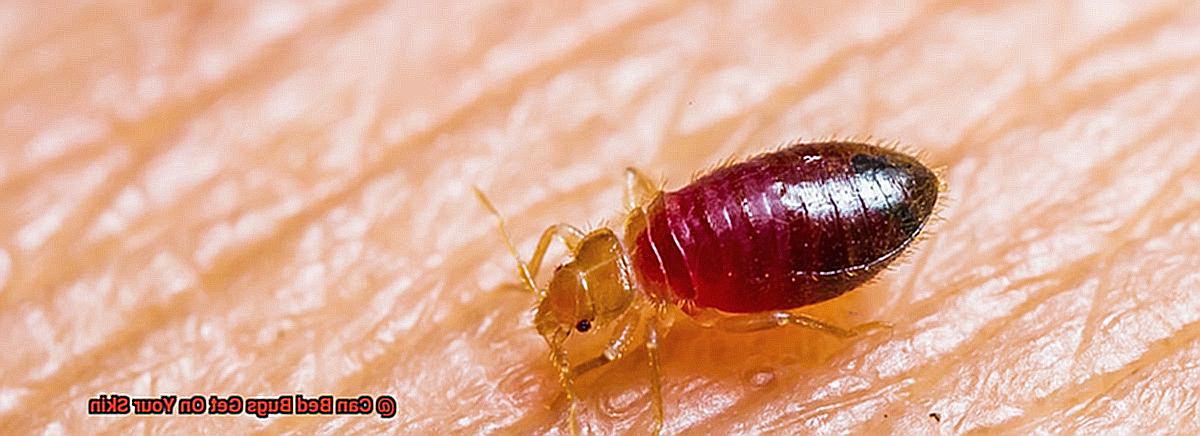
Also Read: Can Bed Bugs Climb Metal Or Plastic?
Conclusion
In summary, bed bugs are annoying insects with no trouble climbing onto your skin and leaving behind irritating bites. They are attracted to our body heat and carbon dioxide, making us easy targets for their blood-sucking habits.
Although they do not live on our skin like lice or fleas, they will crawl onto us to feed before crawling back off again. Simply washing your skin or showering will not rid you of these pests.
Bed bug bites can cause red, itchy welts on your skin that may be arranged in a zigzag pattern or line. Raised bumps accompanied by itching and redness are also signs of bed bug bites.
Wash the affected area with soap and water to treat these bites, apply cold compresses for immediate relief, use over-the-counter anti-itch creams such as hydrocortisone cream or Calamine lotion for persistent itching, and seek medical attention if the bite becomes infected.
Preventing bed bugs from getting onto your skin involves using a bed bug repellent or mattress encasement.
Additionally, keeping your home clean and clutter-free by regularly vacuuming carpets, floors, and furniture and washing bedding and clothing in hot water is essential. Inspecting second-hand furniture or clothing before bringing it into your home is also crucial.
Getting rid of bed bugs in your home requires locating all of their hiding places through a thorough inspection before using insecticides or heat treatments.
Professional help is often necessary to eliminate these pesky creatures, as they have access to powerful insecticides and specialized equipment that can target bed bugs in hard-to-reach areas.

